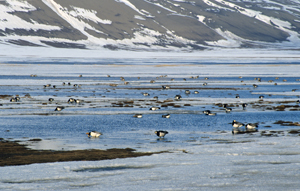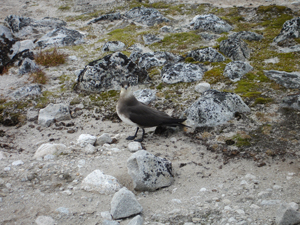 Thousands of barnacle geese and pink-footed geese rest in Adventdalen after arriving in the spring. (Image: Øystein Overrein/The Norwegian Polar Institute)
Thousands of barnacle geese and pink-footed geese rest in Adventdalen after arriving in the spring. (Image: Øystein Overrein/The Norwegian Polar Institute)
 Arctic skua is a common species in the Isfjorden area. (Image: Lise Øvrum/The Governor of Svalbard)
Arctic skua is a common species in the Isfjorden area. (Image: Lise Øvrum/The Governor of Svalbard)
 Polar bears are not often spotted in Isfjorden in the summer, but with a little luck you will come across their footprints in the fine-grained sand. (Image: Lise Øvrum / The Governor of Svalbard)
Polar bears are not often spotted in Isfjorden in the summer, but with a little luck you will come across their footprints in the fine-grained sand. (Image: Lise Øvrum / The Governor of Svalbard)
Isfjorden and its surrounding areas are, by Svalbard standards, highly productive in biological terms. The fjord system is influenced by branches from the ocean current, which travels along the west coast of Spitsbergen (the so-called West Spitsbergen Current) and periodically during the year pours relatively warmer, saltier surface water into the fjord. Cold freshwater comes from the fronts of the glaciers. This accounts for a vertical circulation of water layers and a high level of biological production of phytoplankton. The algae are eaten by various small crustaceans. These are fed upon by larger crustaceans and fishes such as capelin and polar cod. These, in turn, support large quantities of seabirds and marine mammals.
There are not very many different species of seabirds in the Isfjorden area, but several of the species occur in big numbers and are concentrated in large breeding colonies. The presence of the seabirds supports rich vegetation growth in the areas around the bird cliffs, to the benefit of terrestrial animals, such as ptarmigans, foxes and geese. Arctic foxes – feeding on eggs, chicks and birds – have a stable food supply around the bird cliffs.
In the summer the large bird cliffs attract attention with their high levels of breeding activity and bird traffic. Several of the islands and islets in Isfjorden are important for breeding geese, ducks, waders and gulls. In addition to this, most of the small lakes and ponds along the coast are important breeding and feeding areas for species such as grey phalarope and other waders, as well as king eider, red-throated diver and long-tailed duck. Such areas are also important resting and moulting areas for geese. Examples of such areas are Erdmannflya, Bohemanflya, lower areas of Gipsdalen, Sassendalen, Adventdalen, Colesdalen and Kapp Linné.
Geese, ducks and auks moult over a period of 3-7 weeks during summer and autumn. During this period they are not able to fly and are therefore very vulnerable.
All the common bird cliff species are represented in Isfjorden: little auk, Atlantic puffin, Brünnich’s guillemot, glaucous gull, black guillemot, northern fulmar and black-legged kittiwake. All of these species, apart from the glaucous gull, breed in the mountain of Templet in Sassenfjorden and in Skansbukta in Billefjorden. The bird cliff Fuglefjella by Grumant has the same species, except for northern fulmar. In Fjordnibba in Tempelfjorden and Gipshuken south-east of Billefjorden, Atlantic puffin, Brünnich’s guillemot, glaucous gull, black guillemot and northern fulmar can be found. Diabasodden has the same species apart from northern fulmar. In Tschermakfjellet in Nordfjorden, Brünnich’s guillemot, northern fulmar and black-legged kittiwake are the dominant species, while Atlantic puffin, Brünnich’s guillemot, black guillemot and black-legged kittiwake are found in Alkhornet. There are large colonies of northern fulmar in Nøisdalen and Borgen in the vicinity of Dicksonfjorden.
Apart from the bird cliffs, Isfjorden has several other important bird localities. Three of the 15 bird sanctuaries in Svalbard can be found in the Isfjorden area. Kapp Linné by Isfjord Radio is home to species such as barnacle geese, common eider, king eider, Arctic tern, ruddy turnstone, long-tailed duck, purple sandpiper, grey phalarope, Arctic skua and ringed plover.
The islands of Gåsøyane by the outlet of Billefjorden is an area of international value because of the high number of birds and bird species that can be found here. (The area is on the Ramsar List of Wetlands of International Importance, resulting from an international treaty which was established in 1971). There is a large breeding population of common eider, barnacle geese, pink-footed geese, brent geese, Arctic tern, grey phalarope, glaucous gull and great black-backed gulls here.
The Boheman bird sanctuary consists of several islands and islets surrounded by shallow waters. There is a large breeding population of common eider, barnacle geese, glaucous gull and great black-backed gulls here.
Other birdlife around the Isfjorden area includes a significant number of breeding barnacle geese, which breed on islands and islets, and pink-footed geese, which breed on steep slopes further away from the sea. The larger and more lush valleys are important areas. Breeding barnacle geese are also found in steep terrain below the bird cliffs. The areas around Isfjorden are among the best areas for Svalbard rock ptarmigan. Most of the 800-1500 ptarmigans that are hunted in Svalbard every year are shot here.
In the summer one can be lucky enough to find polar bears by the glacier fronts to the north of Isfjorden. They lurk around here in search of seals. In the spring the ringed seal bears its pups on the fjord ice, and the surest place to find ringed seals and bearded seals in the summer is in front of the glaciers.
The areas south and east of Isfjorden are home to the largest population of reindeers in Svalbard. In Nordenskiöld Land there are an estimated 4500 animals, and the reindeer density is higher than at any other place in Svalbard. The coastal plain of Daudmannsøyra has several hundred reindeer.
A large population of Arctic fox inhabits the Isfjorden area. The Arctic fox was avidly hunted in earlier times, when the white and particularly the bluish-grey winter pelts of the foxes were economically valuable. Today hunting still takes place, but on a smaller scale. It is worth noting that in the 1900s there were several incidents of rabies amongst the Arctic foxes in Svalbard. If foxes behaving strangely (aggressively, unnaturally lacking shyness, etc.) or dead foxes are observed, the Governor of Svalbard must be alerted immediately.
By the settlement of Grumantbyen and the mountain Fuglefjella, there is a local population of an introduced small rodent, the sibling vole. The size and distribution of the vole population depends on the winter conditions. People who visit these areas must be aware that the sibling vole is host to a parasite called Echinococcus multilocularis. The parasite inhabits mostly Arctic foxes, cats and dogs. It can be contagious to humans, and can lead to severe liver damage. It is not advised to drink water from creeks or to gather mushrooms in the area due to the risk of infection.



 Norsk
Norsk